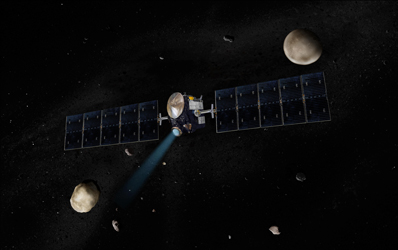


|

|
 |
|
Asteroids may reveal details of Jupiter's formation KEITH COOPER ASTRONOMY NOW Posted: September 14, 2009 The asteroids Vesta and Ceres may have borne the brunt of Jupiter’s increasing influence in the early Solar System, according to new research being presented today at the European Planetary Science Congress (EPSC) in Potsdam, Germany. NASA’s Dawn spacecraft will arrive at Vesta in 2011, and Ceres in 2015. They are the two largest asteroids in the Solar System; indeed, Ceres is classed as a dwarf planet and is 950 kilometres wide. According to Dr Diego Turrini and colleagues at the Italian National Institute for Astrophysics in Rome, if Jupiter formed from the bottom up then the asteroids should reveal this in the pattern of craters on their surface.  NASA's Dawn spacecraft will encounter both Ceres and Vesta during the next decade. Image: NASA/JPL.
NASA's Dawn spacecraft will encounter both Ceres and Vesta during the next decade. Image: NASA/JPL.
Their reasoning works as follows: they described Jupiter’s formation in three phases, 1) the accretion of Jupiter’s core, 2) a rapid accumulation of gas from the solar nebula from which the stars and planets formed, and 3) a slower accretion of gas around four billion years ago. They then simulated how the increasing mass and gravity of Jupiter would affect the orbits of comets and asteroids, and how they collided with one another. “We found that the stage of Jupiter’s development made a big difference on the speed of impacts and the origin of potential impactors,” says Turrini. “When Jupiter’s core approaches its critical mass, it causes a sharp increase in low velocity impacts from small, rocky bodies orbiting nearby to Vesta and Ceres. Once Jupiter’s core has formed and the planet starts to rapidly accrete gas, it deflects more distant objects onto a collision course with Ceres and Vesta and the impacts become more energetic.” The latter stages of Jupiter’s construction also coincide with the Late Heavy Bombardment between 4.1 and 3.8 billion years ago, when the gas giants began migrating outwards, flinging comets and asteroids everywhere, bombarding the inner Solar System. “If we see evidence of an underlying intense, uniform crater pattern [on Ceres and Vesta], it will support the theory that one or both of these minor planets formed during the final phases of Jupiter accretion,” says Turrini. To find out more about EPSC, visit http://meetings.copernicus.org/epsc2009/ |
|
|
|
|